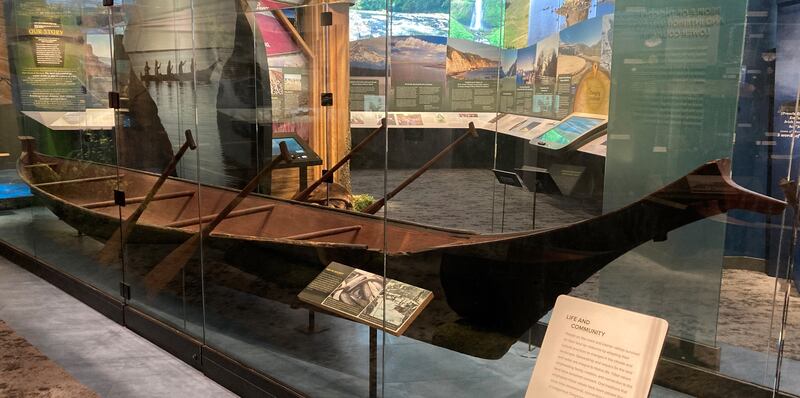For the past decade, Nicole Yasuhara has helped the Oregon Historical Society work toward giving back stolen objects. That’s a big reason why the downtown Portland history museum didn’t spend the past month in the same panic as its peers.
Across the country, prestigious museums started the year by covering up their displays. The Smithsonian Institution closed two exhibit halls in the Museum of American History. The Field Museum in Chicago concealed its display cases behind brown paper and gray curtains. In Oregon, Gov. Tina Kotek pulled a dormant task force out of mothballs to advise museums on what to do next.
The source of the anxiety? New rules from the Biden administration requiring museums to obtain the consent of Native tribes before displaying cultural items deemed sacred or used in funerals. Many of those objects arrived at museums because people looted Native communities and pillaged graves in decades past.
Yasuhara can offer tips on what to do with such ill-gotten gains. She arrived at OHS in 2008, assumed responsibility for its collections in 2014, and has risen to deputy museum director. That gives her responsibility for every object on display at the historical society. It also means she’s in charge of returning some items the museum badly wishes it didn’t have.
Last week, Yasuhara invited WW to the museum to discuss how it displays Native items, what she’s learned from tribes about their belongings, and why certain objects simply shouldn’t be exhibited. The interview has been edited for brevity and clarity.
WW: When did you realize you had items in your collection that could present a problem?
Nicole Yasuhara: Right away, and that’s not a surprise. Any museum professional going into a position at a new institution just knows that’s going to be an issue.
For instance, there are still items in our collection that we are concerned could be cultural patrimony—something that a tribe or native Hawaiian organization can’t give away because it belongs to the community. There are sacred objects and funerary objects.
There are still human remains in our collection. So that was the first question to ask: Why are they in the collection? And the reason they were still in our collection is because they were unaffiliated.
What does “unaffiliated” mean?
We didn’t know exactly where they came from. So we didn’t know where to go from there. Who do you even contact? Who do you consult with if you don’t even know where these remains came from? Luckily, we don’t have very many. It’s less than two dozen, whereas some institutions have thousands.
We know most of ours came from an organization called the Oregon Alpine Club. They were active all throughout the Cascades, which includes hundreds of tribes that would be affiliated in California, Oregon and Washington. But we were able to then do osteological, non-invasive analyses to determine the color of the cranium or specific markers.
Are these full skeletons?
Mostly it’s craniums. We treat this with a lot of respect and don’t publicize all that information. We are communicating respectfully and treating the remains respectfully and working toward repatriating them into their descent communities.
Why is it a problem for a museum to have such items or to display them?
Most of the human remains and funerary objects, cultural patrimony, etc., came into our collection starting from 1898, when we were incorporated, probably through the first 30 years. And how were they coming into our collection? People were actively searching for them. We would call that grave robbing. And I think everybody would agree, grave robbing is wrong. That’s what happened. We don’t condone robbing graves. We should pay respect to these individuals.
Was there a lot of grave robbing when this museum was founded?
Oh, yes. I mean, they considered it “salvage anthropology.” They would study the size of the cranium. They were trying to prove these differences in people’s races.
What’s an example of an item that you used to have on display that’s now been returned?
We recently repatriated an individual’s human remains to the Confederated Tribes of Siletz Indians. And it feels very good to be able to say that. That was just in 2022. But before that, probably the most highly publicized item that we repatriated was the peace medal. [Editor’s note: The Jefferson peace medal, one of many given to tribes by Lewis and Clark’s Corps of Discovery, was returned in 2009 to the Confederated Tribes of the Umatilla Indian Reservation.]

How have you consulted with tribal leaders to display items differently?
The largest item you’ll see in the Experience Oregon exhibit is the canoe. Before the canoe was put on display, before the exhibit was open, the tribal members came over. Everybody else had to leave, and they did a special ceremony, blessing the canoe and washing it, as I recall it. They recommended washing the canoe because it’s supposed to live in the water. Thirty years ago, I think that would’ve really shocked a museum professional. And now we were like, can we get you buckets? Can we get you washcloths?
What’s the most interesting thing you’ve learned while talking with tribes about their items?
It’s really this idea of cultural items relating to the tribes of North America: Some of them are considered not just objects. We might think of a basket as a basket, made 200 years ago. But then they pass it down through the generations and everybody uses it, and they might even use it for different purposes. And it takes on a life of its own.
That’s something that I’m continually thinking about: not just treating objects as objects, but as almost having a spirit of their own. And that’s one of the reasons why we’ve moved to calling them belongings instead of objects.
Is there a way that people who are visiting the museum should treat belongings when viewing them?
If something required a certain type of etiquette, I don’t think that we would display it, especially now. But one thing that I have found is a lot of people will ask, well, how old is it? And when we ask most of our tribal contacts, is this 200 years old? Is this from 1850? They really shy away from that because it could have been made in 1700 and used in 1950. So you’ll notice that a lot of our Native and North American objects we don’t actually put a date on because we’re trying to respect that. But it does drive our visitors crazy.
GO: Oregon Historical Society, 1200 SW Park Ave., 503-222-1741, ohs.org. 10 am–5 pm Monday–Saturday, noon–5 pm Sunday. $10, children free. Multnomah County residents get free admission.

